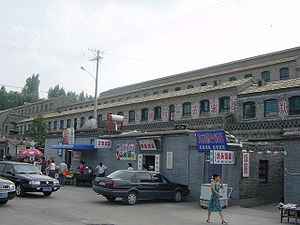- Dazhai, Xiyang County
-
Dazhai (Chinese: 大寨; pinyin: Dàzhài; literally "great outpost") is the name of a mountainous North China village of several hundred farmers in Xiyang, Shanxi, in the People's Republic of China. Dazhai had been an ordinary village until the 1960s, when Mao Zedong published his Supreme Directive, "Learn from Dazhai in agriculture" (农业学大寨) and set up Dazhai as a national agricultural model for all the farmers across the country. A socialist agricultural production achieved through the application of Mao Zedong Thought. [1]
Contents
"Learn from Dazhai"
Subsequently, numerous newspaper and magazine stories and books as well as films were published nationwide about how hard and diligently the villagers of Dazhai had worked to build the village into one with not only well-managed fields and bountiful crops, but engineering marvels such as amazing reservoirs and grandiose aqueducts crossing deep valleys for irrigation. They allegedly worked on their own on the principle of self-reliance, without any financial and technical support from the government. A number of songs about Dazhai were popular for a while, the best-known perhaps being Dazhai Yakexi (yakexi is the Mandarin transliteration of the Uyghur word meaning good or great), about a Uyghur farmer telling how happy he was after he visited Dazhai. The song was adapted to a dance in which a Uyghur male sang while six ladies accompanied him with dances in the Uyghur traditional style. Both the singer and the dancers were in clothing typical of the Uyghur nationality, which the Han Chinese people found aesthetically appealing.
The slogans were "Move the mountains to make farm fields," "Change the sky and alter the land," "Work bitterly, diligently, and with extra energy, and build our village into a Daizhai-like one in three years."
During the years until the downfall of the Gang of Four in 1976, particularly the Cultural Revolution, farmers from all over the country were organized to visit Dazhai, and well-trained tour guides took posts on several important scenes to explain to visitors how the villagers in Daizhai made such achievements with their own hands. One of such scenes was the top of the Tiger Head Mountain where visitors could have a panoramic view of the farm fields, the major irrigation projects as well as the residential area of the villagers. Perhaps hundreds of millions of farmers visited the place during the period and the expenses on their trips were paid[citation needed] by the government.
At this time, farmers throughout China were expected to show their political zeal in following Mao Zedong's directive Learn from Dazhai in agriculture. They not only worked during the day, but at night as well, not only in the warm season, but in the depth of winter as well - a dramatic deviation from their age-old practice. In many places, the farmers literally - and blindly - moved hills (sometimes proclaimed as "mountains"), built reservoirs, tunnels, canals, and so on. As mental motivation, loud speakers were installed at work sites to broadcast music and songs and films were shown at night on the scene while the farmers took a break. Unfortunately, many of these large-scale projects were proved utterly useless later.
Meanwhile, a number of leaders of the village made dramatic advances in their political career. Chen Yonggui, the patriarchal leader of the village, was put to the position of vice-premier of the central government despite the fact that he was only semiliterate. (Zhou Enlai was the premier of the time.) Guo Fenglian, the Dazhai party secretary, was a favorite of Jiang Qing (the wife of Mao Zedong), and played a significant part in the Chinese political scene.
This campaign was as much political as it was agricultural, and it came to an abrupt end upon Mao's death in 1976. Today, Dazhai is a tourist attraction.
The industrial counterpart of Dazhai was Daqing, and the corresponding directive given by Mao was Learn from Daqing in industry.
Modern Backlash
In recent years, as China has moved down the 'capitalist road' under Deng Xiaoping, Dazhai has endured ridicule as a symbol of socialist political ideals due to the part it played in promoting communist ideals of communal agriculture [2], especially when one considers the town's featured role in the widespread Mao slogan, "In Agriculture learn from Dazhai."[3]
See Also
- Learn from Daqing in industry (The industrial counterpart of Dazhai)
References
- ^ Spence's "The Search for Modern China" 2nd Edition, p.562
- ^ TIMEasia.com | Visions of China: Dazhai | 9/27/99
- ^ Learn from Dazhai
External links
- China-dazhai.com - a comprehensive website about Dazhai
- Zhao, "Socio-spatial transformation in Mao's China : settlement planning and dwelling architecture revisited (1950s-1970s)", Chapter 5 : Dazhai, a rural settlement, Katholieke Universiteit Leuven, 2007
- Posters of Chen Yonggui
- Soils and Sustainability: Tales from the Loess Plateau
- The Dazhai Spirit gets religion
Shanxi topics Taiyuan (capital) General Geography Cities • Taihang Mountains • Lüliang Mountains • Yellow River • Fen River • Mount Wutai • Mount Hua • Great Wall of China • Xiechi LakeEducation Culture Visitor attractions Categories:- Agriculture in the People's Republic of China
- Township-level divisions of Shanxi
Wikimedia Foundation. 2010.

